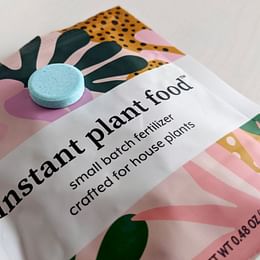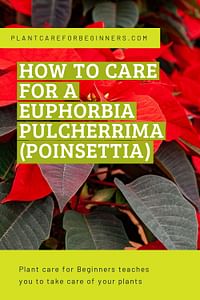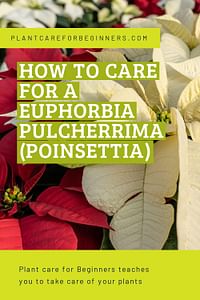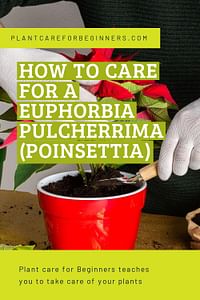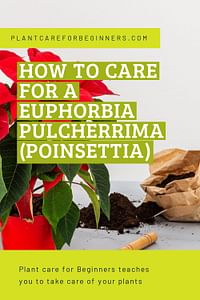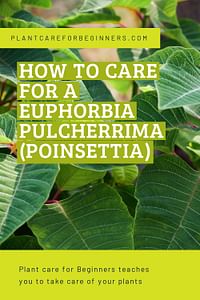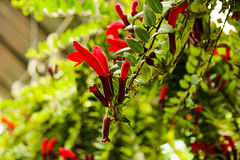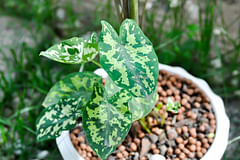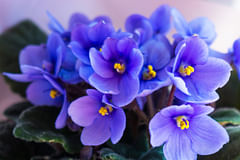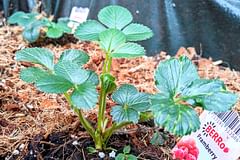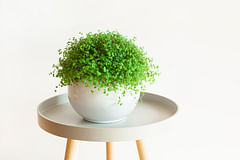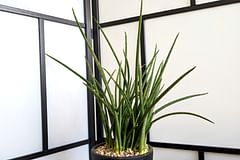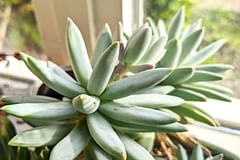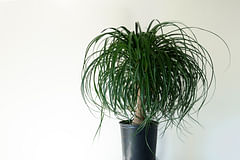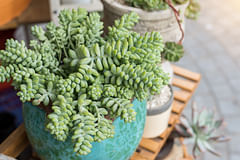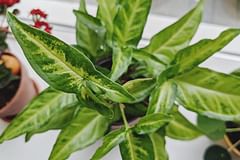How to care for a Euphorbia pulcherrima (Poinsettia)
Learn how to care for a Euphorbia pulcherrima (Poinsettia) houseplant and get it blooming year after year. Get tips on providing the ideal lighting, watering, and fertilizing conditions for this unique houseplant! Perfect guide for both experienced gardeners and beginner plant owners.
Last updated on:
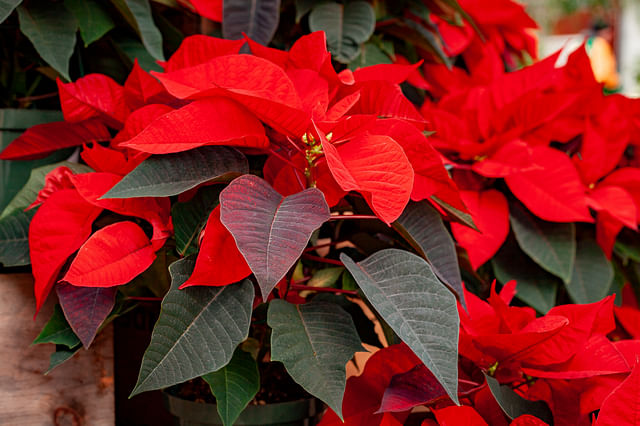 Do you like plants with bright, colorful leaves that make the perfect plant for all types of holidays and special days, like Christmas and Valentine's day? The Euphorbia Pulcherrima, also known as the Poinsettia, might be the perfect plant for you and your house!
Do you like plants with bright, colorful leaves that make the perfect plant for all types of holidays and special days, like Christmas and Valentine's day? The Euphorbia Pulcherrima, also known as the Poinsettia, might be the perfect plant for you and your house!
The Poinsettia is a very popular plant during the Christmas season, because of its bright red and green colored leaves in the winter. It's a plant that's native to Mexico, so it's used to lots of (indirect) sunlight throughout the day. The most interesting part of this plant is the changing leaf color throughout the year.
In this plant care guide, we're going to look at every aspect of taking care of a Poinsettia. We're going to look at these topics:
Let's get started and see how you can keep your Poinsettia healthy throughout the whole year, not just for Christmas!
How often should I water my Poinsettia?
The most important thing to get right when taking care of plants is to water them properly. Watering them too much or too little can make it difficult for your plant to grow well, so let's figure out how much and how often you should water your Poinsettia.
The Poinsettia is a plant that loves to grow in soil that's moist all the time. It doesn't do too well in soil that dries out for more than a day. To help you keep your Poinsettia happy, it's important to water it when the top 2-5 cm (1-2 inches) of the soil is dry.
Another thing to keep in mind when watering your Poinsettia is that it loves moist soil, but can't survive in soggy soil. Soggy soil will cause root rot for most plants, including this one. Luckily, it's quite easy to prevent this by using a pot with a drainage hole and well-draining soil. The soil and pot help you to remove excess water from the pot, so your Poinsettia is never sitting in a puddle of water.
When you use a pot with a drainage hole, it's quite easy to water your plant properly: water your plant thoroughly and let the excess moisture escape out of the drainage hole for about 5 minutes. Your Poinsettia should now be watered properly.
If you start to notice the leaves of your Poinsettia turn yellow, you have either watered your plant too much or too little. If you've got trouble finding out which of these two causes is the real cause, think about the last time you watered your plant. If it was within the last 7 days, you might have overwatered your plant. Otherwise, you might have underwatered your plant and it's time to water it.
What kind of sunlight does a Poinsettia need?
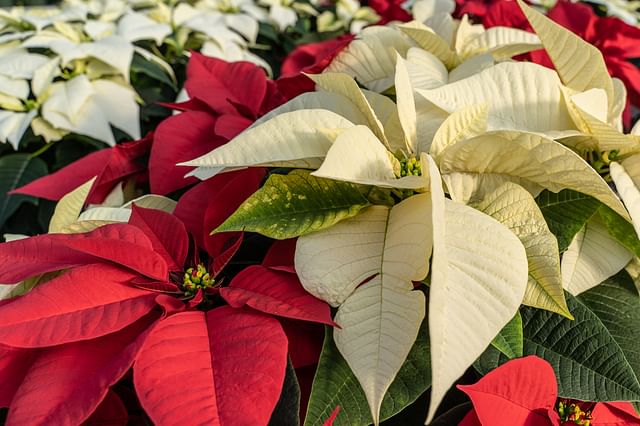
The Poinsettia is native to Mexico and it loves bright, indirect sunlight throughout the day. It doesn't do too well with direct sunlight since that can scorch its leaves. The best spot for a Poinsettia would be close to a south or west-facing window since it'll get enough sunlight throughout the day without too much direct heat.
If the climate in your area is too cold and dark, you can also choose to use artificial light instead of natural sunlight. The Poinsettia needs quite a bit of sunlight, so to keep it happy, make sure it gets at least 6 hours of bright indirect sunlight throughout the day.
What is the ideal temperature for a Poinsettia?
When taking care of houseplants, the temperature around the plant is another important factor that shouldn't be overlooked. To keep it happy, it's best if you keep your Poinsettia between 18-27 °C (65 - 80°F). Ideally, you should put your Poinsettia in a spot that has a consistent temperature throughout the day, because it doesn't handle large temperature shifts very well.
Your Poinsettia can tolerate temperatures below the ideal range as well, but as soon as it starts to dip below 10°C (50°F), your plant will start to suffer from the temperature, which will likely damage the plant. If the temperature goes below freezing, the Poinsettia will, unfortunately, die.
Besides keeping your Poinsettia in a consistently warm spot in your house, it's also important to find a spot that has some humidity. This plant doesn't like dry air like a cactus or succulent would. The Poinsettia likes humidity levels between 50-75%. This range is quite normal for most houses, so as long as you keep your plant away from AC units, air vents, fireplaces, or radiators, you should be just fine when it comes to humidity levels.
If you're struggling to keep the humidity levels high enough for your Poinsettia, you can increase the humidity around your houseplant by misting them with water or placing the pot on a tray filled with pebbles and some water. Just make sure the plant isn't sitting in the water, but rather on top of the pebbles. You don't want to accidentally overwater your plant.
What is the best soil for a Poinsettia?
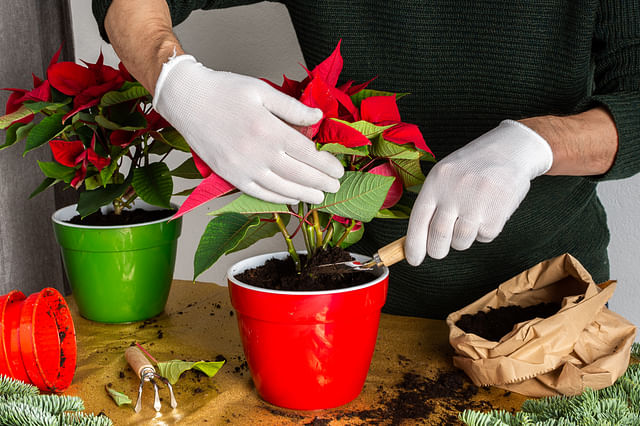 In the section about watering your plant, we've already discovered that this plant thrives in moist soil. Plants that enjoy moist soil most of the time have very different soil requirements from plants that thrive in dry soil. So let's see what the ideal soil for a Poinsettia looks like!
In the section about watering your plant, we've already discovered that this plant thrives in moist soil. Plants that enjoy moist soil most of the time have very different soil requirements from plants that thrive in dry soil. So let's see what the ideal soil for a Poinsettia looks like!
The ideal soil for a Poinsettia contains lots of organic material, has excellent drainage, but also holds onto moisture for a few days to keep the plant happy. This soil mixture contains 1/3 potting soil, 1/3 peat moss, and 1/3 perlite. The potting soil and peat moss provide the plant with organic material to absorb nutrients from, the peat moss and perlite provide structure to the soil and the perlite improves the drainage of the soil mix.
Soil that'll be moist most of the time tends to compact over time, so adding peat moss and perlite to your soil mix helps to preserve the structure of the soil for much longer. This keeps the soil light and airy. This light and airy soil make it possible for oxygen to reach your plant's roots, even after being mostly moist for months. This helps to prevent root rot and promotes healthy root growth.
Now that we've figured out what the ideal soil for a Poinsettia looks like, let's find out if and how often we need to fertilize it to keep it happy.
Should I fertilize my Poinsettia?
Fertilizing your houseplants is often necessary to keep them healthy and growing throughout the year. Poinsettias are no exception! When the growing season starts in the spring, you can start fertilizing your plant with a balanced liquid houseplant fertilizer. This means it should contain equal amounts of potassium, phosphorous, and nitrogen.
You can find out if your fertilizer has equal parts of each of these ingredients by finding a sequence of numbers on the packaging. This looks like 10 - 10 - 10. As long as each of these numbers is equal or close to it, the fertilizer will work for the Poinsettia.
For the best result, you should apply the fertilizer once per month or every other month until late summer/fall when the blooming season for the Poinsettia is about to start. During the winter, you shouldn't fertilize your Poinsettia at all, as it won't use the fertilizer as much and by continuing to fertilize it, you could overfertilize your plant accidentally.
It's important not to overfertilize your Poinsettia, as this can be very damaging to the health of your houseplant. If you overfertilize your plant, it could cause a chemical burn on your plant's roots. If too many of the roots are damaged, this will kill the plant. So don't forget to dilute the fertilizer with water and make sure to read the instructions for your specific fertilizer.
Do I need to prune dead flowers on a Poinsettia?
If you're looking to keep your houseplant nice and healthy, pruning is essential! Pruning helps to remove dead and damaged leaves or blooms and encourages new growth. Removing dead leaves on time is also a great way to prevent pests, as they are attracted to dead and decaying leaves.
When it comes to dead flowers, a Poinsettia should be pruned regularly to encourage the growth of new blooms. Carefully remove any dead or damaged flowers with sharp scissors and cut just above the node. This will help promote healthy new growth for your houseplant and keep it looking vibrant!
In addition to pruning off dead flowers, you should also pinch the tips of stems in mid-summer to encourage bushier growth. Don't worry if this doesn't produce blooms right away - the flowering process takes some time! Make sure to leave some leafy branches at the top so your houseplant can catch enough sunlight and energy to survive.
How do I know when my Poinsettia needs repotting?
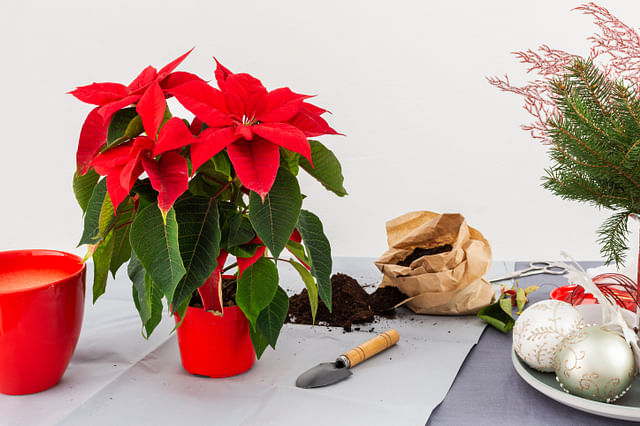 If you're following my advice, you'll water your plant properly, give it plenty of indirect sunlight during the spring and summer, fertilize it regularly, and prune it back to promote growth. By doing all these things well, you'll have a plant that grows quite quickly. Like many other plants, you'll need to transplant your Poinsettia regularly to give it plenty of space to grow new roots and stay healthy. But how do you know it's time to transplant your Poinsettia?
If you're following my advice, you'll water your plant properly, give it plenty of indirect sunlight during the spring and summer, fertilize it regularly, and prune it back to promote growth. By doing all these things well, you'll have a plant that grows quite quickly. Like many other plants, you'll need to transplant your Poinsettia regularly to give it plenty of space to grow new roots and stay healthy. But how do you know it's time to transplant your Poinsettia?
Your Poinsettia will display some signs when it's time to transplant it. If your plant is rootbound, it might start wilting, even though you keep up with watering and fertilizing. If you're using a pot with a drainage hole, you'll also be able to see the roots growing out of the bottom of the pot. If you gently remove your houseplant from its pot, you'll see the roots have almost completely taken over the pot and the roots will have started to circle the bottom of the pot to find more space to grow.
If your houseplant shows any of these signs, it's time to move it into a slightly bigger pot! When you do so, make sure to use fresh soil and follow the instructions for finding or mixing the best soil for a Poinsettia we looked at earlier in this guide.
The most important thing to remember when repotting houseplants is that the new pot should just be 2-5cm (1-2 inches) bigger than the previous one. This prevents root rot and makes your houseplant feel comfortable in its new home. Repotting also gives you a chance to check for pests, so make sure to look out for any signs of pests like webbing or white spots on the leaves before putting it back in its spot.
The size of the new pot is very important because choosing a pot that's too large could develop root rot. Root rot might develop because there is quite a lot of extra soil in the pot after you've repotted your plant. This extra soil holds onto more moisture. If the plant is smaller, it can't absorb all of this extra moisture quickly enough. This will cause the soil to decay and damage the roots of your plant.
What are common pests on a Poinsettia?
Like many other houseplants, Poinsettias are susceptible to common pests. The most common pests you're likely to find on a Poinsettia, are whiteflies, fungus gnats, thrips, and spider mites.
Spider mites thrive in warm and dry environments and feed on the sap of houseplants. They appear as small dots on the underside of your houseplant's leaves and create a web-like structure. If not treated, spider mites can cause the yellowing of your houseplant's leaves or even wilt in extreme cases.
Whiteflies are small sap-sucking insects that can cause serious damage to houseplants. They're usually found on the underside of plant leaves and (like spider mites) feed on the sap of houseplants. Whiteflies turn your plant' sap into a honeydew, which can cause fungal diseases on your plant.
Fungus gnats are small black insects that breed in houseplant soil, particularly when it's moist. They lay their eggs on the surface of houseplant soil and feed on decaying matter in houseplant pots. Fungus gnats don't usually cause much damage to houseplants but can be annoying for houseplant owners who don't want them around.
Thrips are tiny, slender insects that feed on houseplant leaves, making them look pale or bleached in color. They can also spread diseases between houseplants, so if you spot any thrips on your houseplant it's important to treat the infestation immediately.
If you find any signs of pests, act fast! Spray your houseplant with a solution of neem oil or insecticidal soap to get rid of them before they cause more damage.
How can I help my Poinsettia bloom again?
In the introduction, I mentioned that this plant changes the colors of its leaves throughout the year. This has everything to do with the amount of sunlight it receives. During the spring and summer, when the sun is at its strongest, the leaves will be green. But how can you make sure your houseplant will keep flowering year after year?
As soon as the winter starts, when the sun is weaker throughout the day, the Poinsettia will start to bloom. This plant grows leaf-like flowers called bracts. These are the leaves that will turn into other colors, including bright red and pink.
To help your plant grow colored leaves, rather than green leaves, you'll need to introduce your plant to absolute darkness at the beginning of the fall. Poinsettias require ten weeks of complete darkness before they start developing flower buds. This period usually starts in early October and lasts until mid-December.
To make sure your houseplant will get enough uninterrupted darkness, place it away from any sources of artificial light at night, like streetlights or lamps. To help your houseplant develop strong stems, move it to a spot where it will get bright but indirect sunlight during the day.
This sudden change in light exposure prevents the leaves from becoming green, so they turn red or pink. This is can be quite a lot of work, but it's easier if you have a room with black-out curtains to open and close.
Now let's see if we can grow a Poinsettia outside during the summer!
Can you grow a Poinsettia outside during the summer?
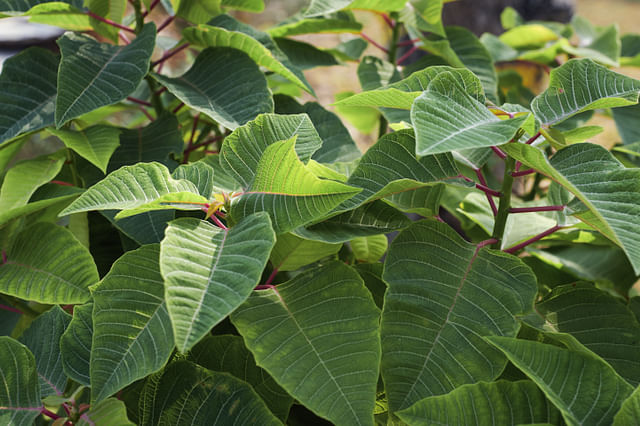 A Poinsettia houseplant can be grown outdoors in the summer if your climate is warm enough. This houseplant likes a warm climate, so if you live in an area that gets below 15°C (60°F) during the night in the summer, you might want to keep growing your plant indoors.
A Poinsettia houseplant can be grown outdoors in the summer if your climate is warm enough. This houseplant likes a warm climate, so if you live in an area that gets below 15°C (60°F) during the night in the summer, you might want to keep growing your plant indoors.
If you decide to grow your houseplant outdoors during the summer, make sure to give it enough light and water as well as fertilize it when needed. When temperatures start dropping below 10°C (50°F) at night, move your houseplant back indoors to prevent any (permanent) damage to your plant.
In short, a Poinsettia houseplant can be grown outdoors during the summer, but only if your climate is warm enough for it.
Conclusion
A Poinsettia is a great choice for those that like to grow a unique plant. It might not be the best choice for a beginning plant owner, as this plant does require regular maintenance. However, if you think you've seen everything plants can throw at you, this is the perfect challenge to overcome. And the results of taking care of this plant are incredible because you can have a bright red or pink houseplant for the winter holidays!
When it comes to taking care of this plant during the spring and summer, it's quite an easy plant, because it just needs a bright spot in your house and regular watering and fertilizing to stay happy. Following these steps will ensure that your houseplant will keep flowering year after year!
Share this plant care guide with your friends and family to help them grow this unique plant throughout the year with the ultimate goal of having a blooming plant during the winter holidays.
Thank you for reading this post! I hope it helps you to keep your plants healthy and beautiful! If you're looking for more guides on specific plants, you can always request a plant guide to get a guide for the plant you have trouble with.
Tags: Plant care tips, moisture-loving, sun-loving, tropical
Posted on: Jan 21, 2023